Mandevilla ‘Rock Trumpet’ Plants – Happiest Grown In A Conservatory Or Greenhouse

CLIMBERS > MANDEVILLA

Ed is a horticultural therapist, professional gardener and writer. Ed has a BSc in Occupational Therapy from Coventry University and a Diploma in Social and Therapeutic Horticulture (DipSTH) via Thive, the RHS and Pershore College. Ed runs a community kitchen garden in West Sussex, where he leads horticultural therapy sessions.
Reviewed By DAN ORI

Dan has over 27 years’ under his belt caring for plants and gardens. Working as a Horticultural Instructor and Consultant, he draws on a diverse range of experience that includes working as a Head Gardener, Tree Surgeon, Garden Centre Trouble Shooter, and writer of academic papers. Dan has a Level 3 Diploma in Horticulture and is currently a candidate for the RHS’s most prestigious award – The Master of Horticulture.
MANDEVILLA GUIDES
Mandevilla were previously classified within the Dipladenia genus, but were separated and re-classified in 1933.1Palumbo, F., Draga, S., Scariolo, F., Gabelli, G., Batta Sacilotto, G., Gazzola, M., & Barcaccia, G. (2022, August 16). First genomic insights into the Mandevilla genus. Frontier. Retrieved March 21, 2023, from https://www.frontiersin.org/articles/10.3389/fpls.2022.983879/full
Nevertheless, these plants are sometimes referred to as being one and the same.
They are probably better known as ‘Chilean Jasmine’ or ‘Rock Trumpet’ and are named after Henry Mandeville, an English diplomat and botanist.2Mandevilla. (n.d.). Heemskerk Flowers. Retrieved March 21, 2023, from https://en.heemskerkflowers.com/mandevilla
Mandevilla are usually climbers with showy, sometimes scented, flowers opening in the summer.
However, they originate from warmer climates – meaning they are tender and are happiest grown in a conservatory or greenhouse here in the United Kingdom.
Overview
| Botanical Name | Mandevilla |
| Common Name(s) | Dipladenia, Rock Trumpet, Chilean Jasmine |
| Plant Type | Climber / Houseplant |
| Native Area | Americas |
| Hardiness Rating | H2/H3 |
| Foliage | Semi-evergreen climber |
| Flowers | Large, showy flowers |
| When To Sow (Indoors) | April, May |
| Flowering Months | May, June, July, August, September |
| When To Prune | March |
Sunlight
Preferred
Dappled / Partial Shade
Exposure
Sheltered (Indoors)
Size
Height
1 – 2M
Spread
0.1 – 0.5M
Bloom Time
May – October
Soil
Preferred
Loam
Moisture
Moist but well drained
pH
Neutral / Acidic
Mandevillas are perennial climbers that originate from North, Central and South America.3Mandevilla. (n.d.-b). Kew Royal Botanic Gardens. Retrieved March 21, 2023, from https://powo.science.kew.org/taxon/urn:lsid:ipni.org:names:328998-2
They are stunning ornamentals that can have red, yellow, pink or even white flowers that are often scented and can bloom for months on end during the summer.

Flowers are produced on the current year’s new growth and it is important to provide the right warm and humid conditions for the new shoots to grow to produce blooms later in the year.
Varieties that are commonly available here in the United Kingdom include:
Mandevilla sanderi
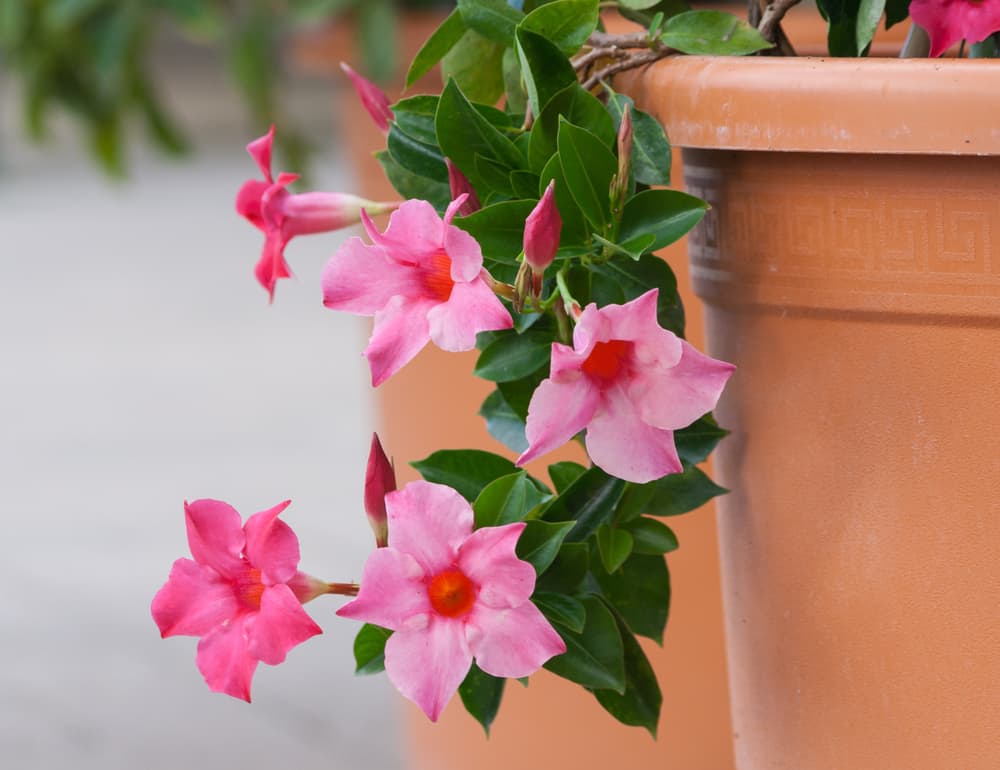
M. laxa AGM
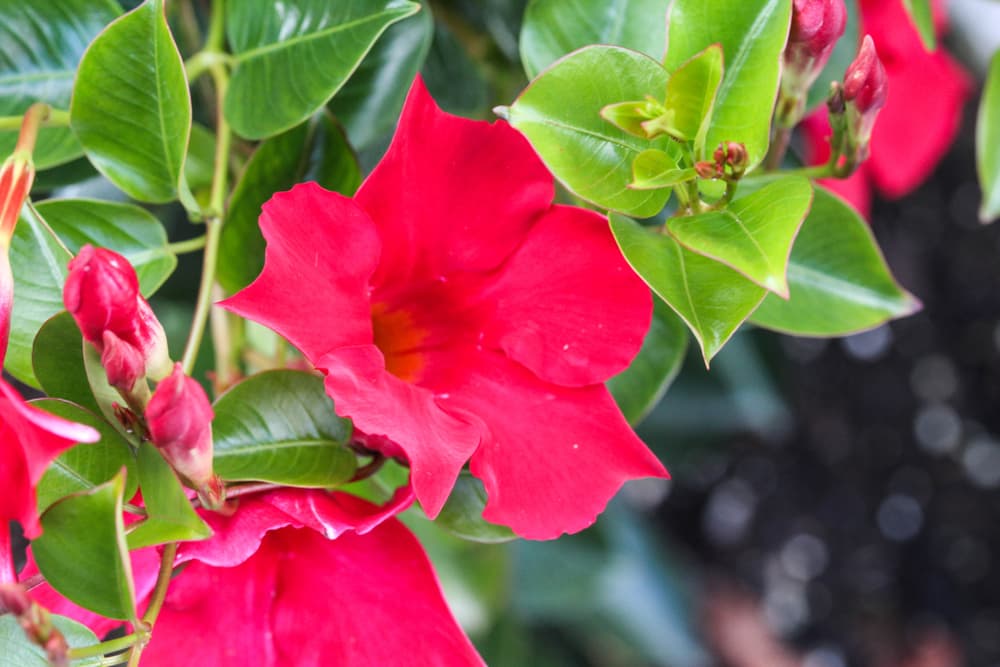
M. boliviensis AGM
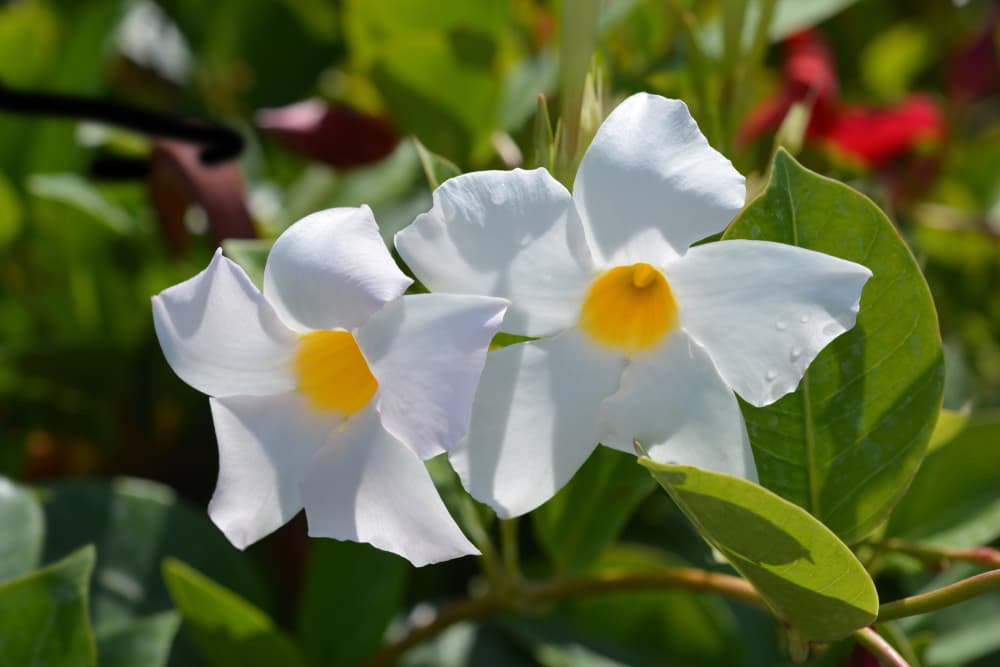
Mandevilla is a great climber, with an exotic feel and easily grown in a pot.
It can be a great addition to a conservatory or even an outside terrace, but only during the warmer months.
How To Grow Mandevilla
Mandevillas are most commonly grown from small plants available from local plant nurseries or online.
They need indoor protection during the colder months and prefer full sunshine, although will need shading from the hot midday sun.
Mandevillas are tender plants and need to be kept over winter in temperatures above 10°C and during spring require a humid and warm environment with temperatures of 18°C at night and 21°C during the day.
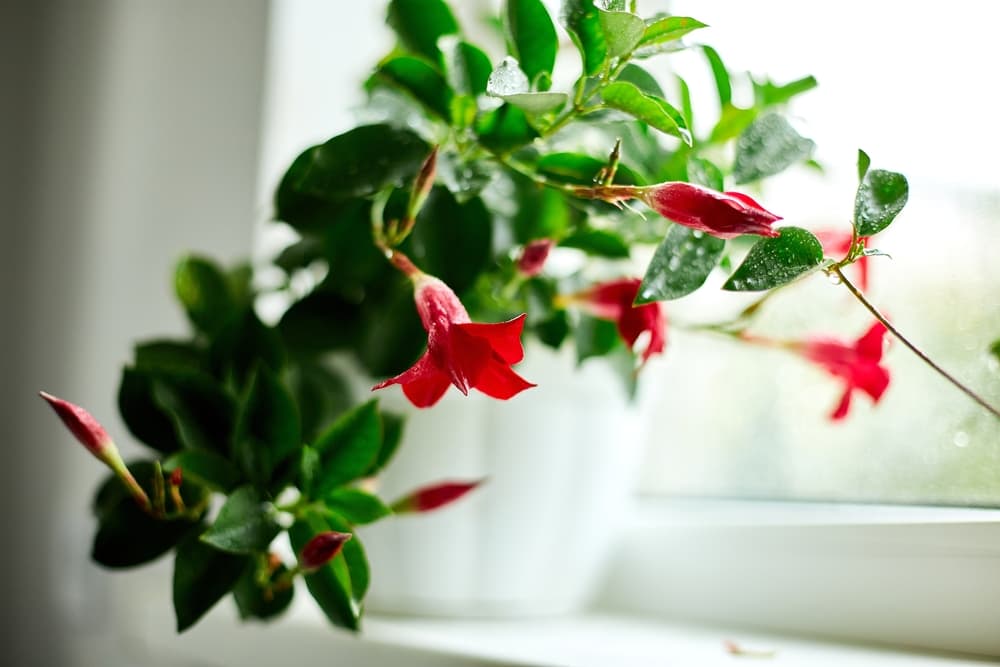
However during the summer months, they can be placed outdoors in a sheltered and sunny spot.
Mandevilla can be grown from seed in spring, but will need the warmth of a propagator to help them to germinate, or grown from softwood cuttings taken in early summer.
If taking cuttings, new growth must be selected and in order to take root will need the bottom heat of a propagator.
Where To Grow
Mandevilla prefer full sun and a sheltered spot to grow well and produce the wonderful blooms they are known for.
They are most commonly grown in pots so they can easily be moved depending on the seasons.
Due to their temperature requirements, they are often grown in a conservatory or heated greenhouse and only placed outside during the warmest months of the year.
Supports
Supports are required for the climbers to grow up.
Bamboo canes forming a tripod are often provided in the pot when bought, but in time and depending on space a taller support will be required.

Longer term, metal climbing supports such as obelisks are ideal as they will not rot over time and provide a strong frame for the plant to grow upon.
Mandevilla Plant Care
To plant Mandevilla fill a pot with a free-draining, soil-based compost such as John Innes No.2 and plant at the same depth as previously planted.
The shoots will need tying-in to begin with and the tops can be pinched out to promote bushier growth if required.
Watering
During the growing season, Mandevilla will need watering and feeding often, they do not like to have wet roots so make sure there is adequate drainage.
During the winter months, growth will slow and the plant will need less moisture so reduce watering and cease feeding until spring.
Repotting
Mandevilla are grown for their flowers, which are only produced on new growth.
Thus it is important to care for the plants during spring when the plant begins growing again after winter.
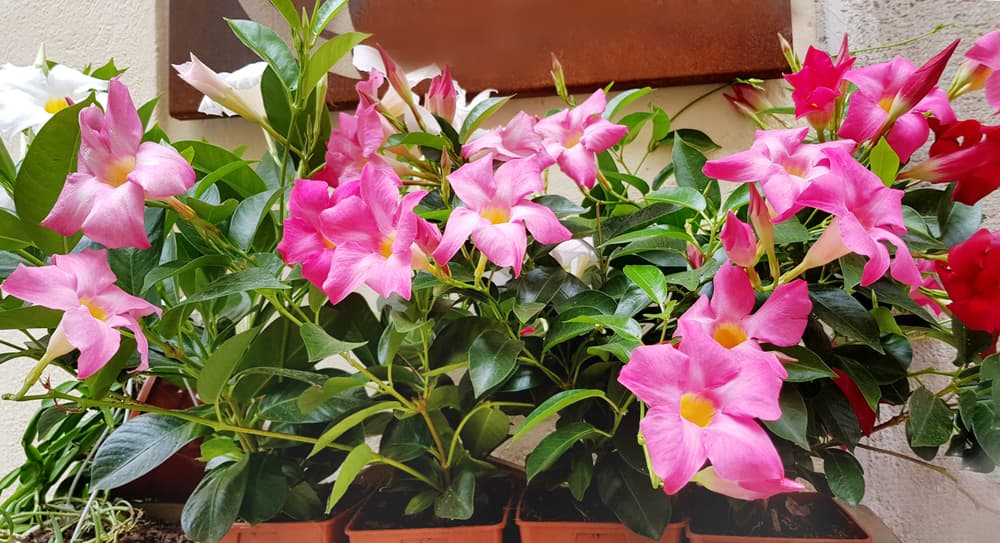
It is recommended that Mandevilla are re-potted each spring with fresh compost and a larger pot as required.
Pruning
Depending on the variety, Mandevilla can grow to 4.5M tall.
However, M. sanderi will usually grow to no more than 1.5M and thus might reach a better size if pot-grown and moved around depending on the seasons.
Mandevilla are classed as RHS pruning group 12 and require pruning in late winter or early spring before any new growth appears.4Climbers and wall shrubs: pruning established plants. (n.d.). Royal Horticultural Society. Retrieved March 21, 2023, from https://www.rhs.org.uk/plants/types/climbers/established-pruning-guide
To prune, cut back any side shoots to 3-4 buds from the main framework and cut back any vertical stems outgrowing the supports.
“Don’t be tempted to prune after mid-March as you could delay or stop flowering for that year because blooms break from the current year’s growth,” says Master Horticulturist Dan Ori.
“I find it convenient to prune and repot these plants at the same time each February.”
Common Problems
Pests
Mealybugs are insects that feed on the sap of house and greenhouse plants, including Mandevilla.
The telltale sign of mealybugs is a white fluffy residue left on the leaves and in the leaf joints.
Aphids are also common with Mandevilla (I had recurring infestations when growing as a houseplant) and they are usually visible with the naked eye.
Mealybugs or aphids do not mean the plant is destined for the compost pile, but can easily be dealt with if quick remedial action is taken.
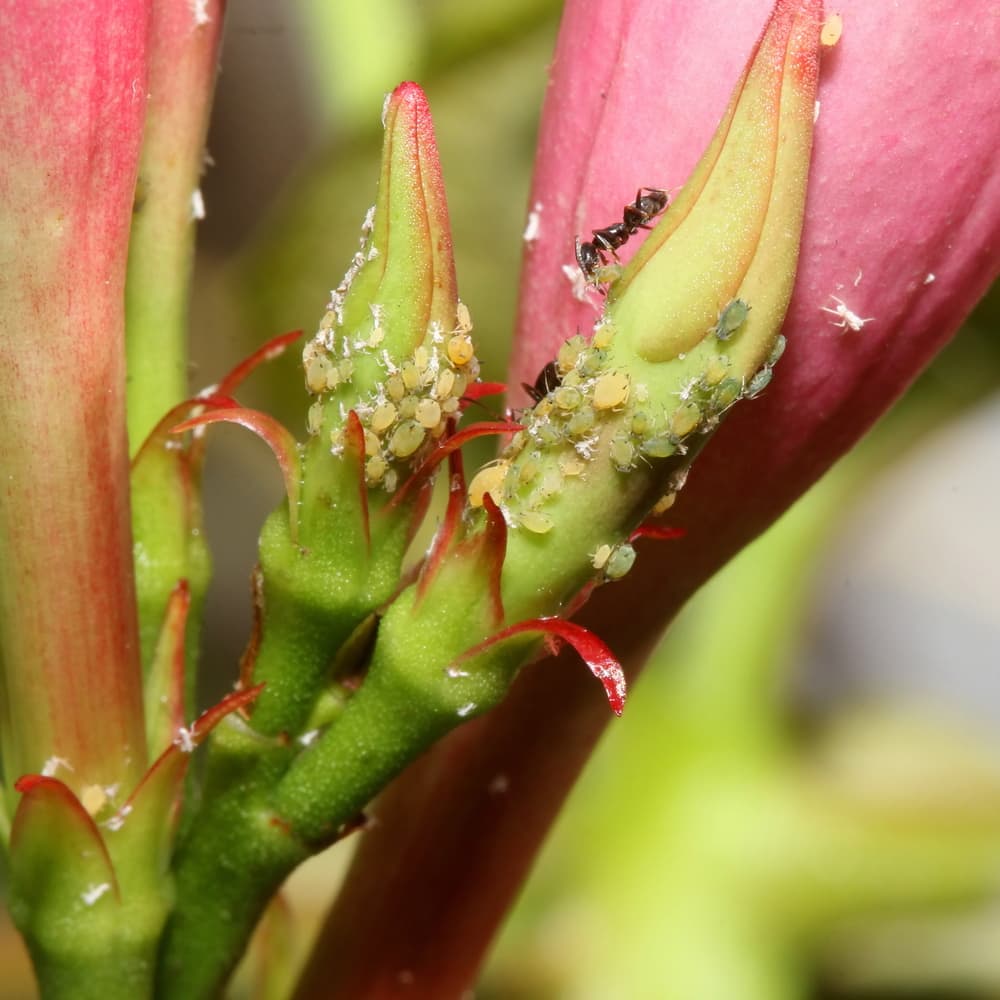
Firstly remove the affected plant from any others to avoid any spreading and contamination.
Wipe away any sign of mealybugs or aphids from the plant using a wet sponge or baby wipe and remove any damaged leaves which may harbour eggs.
Ladybirds like to eat mealybugs or aphids and their eggs and can be introduced during the summer months as a non-pesticidal approach.
Pesticide control can include spraying the affected plant with plant oils, fatty acids and natural pyrethrum.
I had particular success by removing aphids by hand, then spraying with neem, which seemed to make the surface of the plant a no-go zone for pests.
Not Flowering
Mandevilla needs the correct pruning regime, seasonal environment conditions and nutrients in order to flower.
It is important not to prune the plant any later than spring as the new growth and subsequent blooms may be pruned off accidentally.

Flowers are produced on new growth and thus it is important to make sure that the conditions are correct for the new shoots to appear.
The correct temperature, soil kept moist (but not wet) and feeding the plant from spring onwards should help encourage the flowers to bloom.
Leaves Falling Off
Mandevilla are semi-evergreen and may drop some leaves during the winter months, this can be seasonal and nothing to worry about.
However, if leaves are dropping during the summer then check you are not over or under-watering the plant and that there are no obvious pests, such as mealybugs on the plant.
References
- 1Palumbo, F., Draga, S., Scariolo, F., Gabelli, G., Batta Sacilotto, G., Gazzola, M., & Barcaccia, G. (2022, August 16). First genomic insights into the Mandevilla genus. Frontier. Retrieved March 21, 2023, from https://www.frontiersin.org/articles/10.3389/fpls.2022.983879/full
- 2Mandevilla. (n.d.). Heemskerk Flowers. Retrieved March 21, 2023, from https://en.heemskerkflowers.com/mandevilla
- 3Mandevilla. (n.d.-b). Kew Royal Botanic Gardens. Retrieved March 21, 2023, from https://powo.science.kew.org/taxon/urn:lsid:ipni.org:names:328998-2
- 4Climbers and wall shrubs: pruning established plants. (n.d.). Royal Horticultural Society. Retrieved March 21, 2023, from https://www.rhs.org.uk/plants/types/climbers/established-pruning-guide
